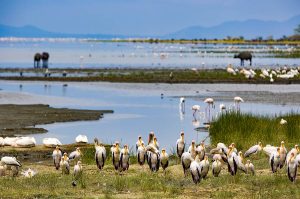LAKE MANYARA NATIONAL PARK
Nestled at the base of the Great Rift Valley escarpment, Lake Manyara National Park is a hidden gem in northern Tanzania. This park, covering approximately 330 square kilometers, offers a unique blend of diverse ecosystems, making it a haven for wildlife enthusiasts, birdwatchers, and those seeking a tranquil escape into nature.
Geographical Features and Location
Lake Manyara National Park is strategically located between the vibrant town of Arusha and the iconic Ngorongoro Conservation Area. The park’s landscape is a tapestry of dense forests, open grasslands, and the glistening Manyara Lake, providing a variety of habitats for its rich biodiversity.
Flora and Fauna
Tree-Climbing Lions
One of the park’s unique attractions is its population of tree-climbing lions. Unlike their counterparts in other regions, the lions of Lake Manyara have developed the peculiar habit of resting on the branches of acacia trees. This behavior offers visitors a rare and captivating sight, as these majestic predators survey their surroundings from elevated perches.

Rich Birdlife
Lake Manyara National Park is a paradise for bird enthusiasts, with over 400 bird species recorded within its borders. The alkaline-rich waters of the lake attract flocks of flamingos, pelicans, and a myriad of other waterbirds. The park’s diverse habitats also provide a home for hornbills, eagles, and colorful songbirds, making it a birdwatcher’s delight.
The Manyara Lake
Alkaline Waters and Aquatic Life
The centerpiece of the park, Lake Manyara, is a shimmering expanse of alkaline waters that supports a rich aquatic ecosystem. The lake is home to various fish species, creating a vital food source for the park’s wildlife. The reflective surface of the lake adds to the park’s scenic beauty, especially during sunrise and sunset.
Hippopotamus and Crocodile Sightings
As visitors explore the park, they may encounter pods of hippos lazily lounging in the shallows or basking in the sun along the lake’s edge. Crocodiles, stealthy and patient, can also be spotted near the water’s surface, creating thrilling moments for those on safari.

Canopy Walk and Treetop Adventures
For those seeking a more adventurous experience, Lake Manyara National Park offers a unique canopy walk. Suspended above the treetops, this walkway provides breathtaking views of the park’s landscapes and allows visitors to observe wildlife from a different perspective. It’s a thrilling adventure that adds an extra layer of excitement to the safari experience.
Cultural Interactions with the Maasai
Lake Manyara National Park provides opportunities for cultural interactions with the Maasai people. Visitors can engage in cultural tours, learning about the traditional practices, customs, and vibrant attire of the Maasai, who have coexisted with the wildlife in this region for generations.
Conservation Efforts
Conservation initiatives within Lake Manyara National Park focus on preserving the delicate balance of its ecosystems. Efforts include habitat restoration, anti-poaching measures, and community involvement to ensure the sustainable coexistence of wildlife and local communities.
Best Time to Visit
The best time to visit Lake Manyara National Park is during the dry season, from June to October, when wildlife congregates around the lake, offering optimal opportunities for sightings. However, the wet season, from November to May, transforms the landscape into a lush green paradise, attracting migratory birds and providing a unique perspective.
Accommodation Options
Lake Manyara National Park offers various accommodation options, ranging from luxury lodges overlooking the lake to more rustic tented camps nestled within the park. Each option provides a comfortable and immersive experience, allowing visitors to reconnect with nature.

Tips for Visitors
- Binoculars and Cameras: Bring binoculars and cameras to capture the diverse wildlife and bird species.
- Sun Protection: Given the park’s open landscapes, bring sunscreen, a hat, and sunglasses for sun protection.
- Guided Tours: Opt for guided tours to enhance your understanding of the park’s flora, fauna, and cultural significance.
Conclusion
Lake Manyara National Park, with its tree-climbing lions, diverse birdlife, and scenic landscapes, offers a serene escape into the wonders of nature. Whether you’re exploring the treetops, engaging with the Maasai culture, or enjoying a peaceful moment by the lake, this park is a testament to Tanzania’s rich biodiversity.
FAQs
Are tree-climbing lions unique to Lake Manyara National Park?
- Yes, the tree-climbing lions in Lake Manyara are a unique phenomenon not commonly observed in other regions.
Can I swim in Lake Manyara?
- Swimming in Lake Manyara is not allowed due to the presence of hippos and crocodiles.
What is the significance of the alkaline waters in the lake?
- The alkaline waters support a diverse aquatic ecosystem, attracting a variety of fish and bird species.
Are there night safaris in Lake Manyara National Park?
- Night safaris are generally not offered in the park to minimize disturbance to the wildlife.
Is the canopy walk suitable for all visitors?
- The canopy walk is designed to be accessible to most visitors, but it’s advisable to check with park authorities for any specific restrictions.
